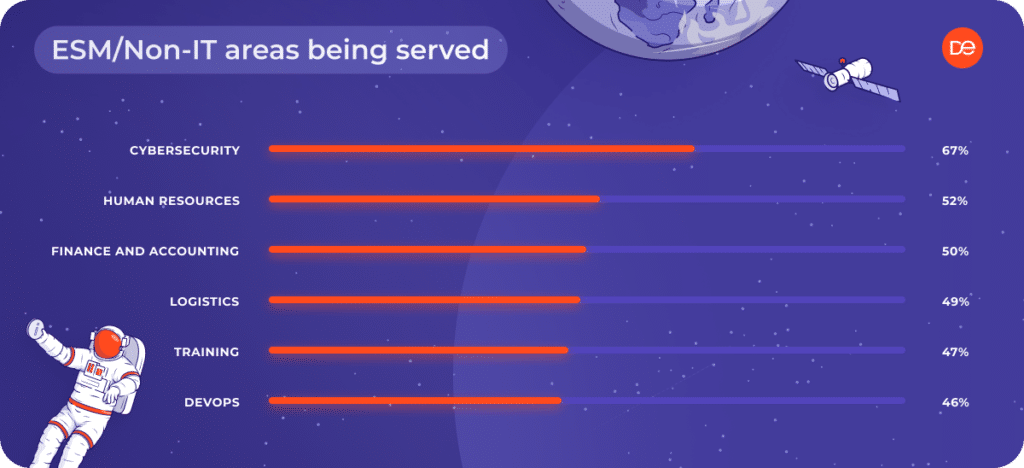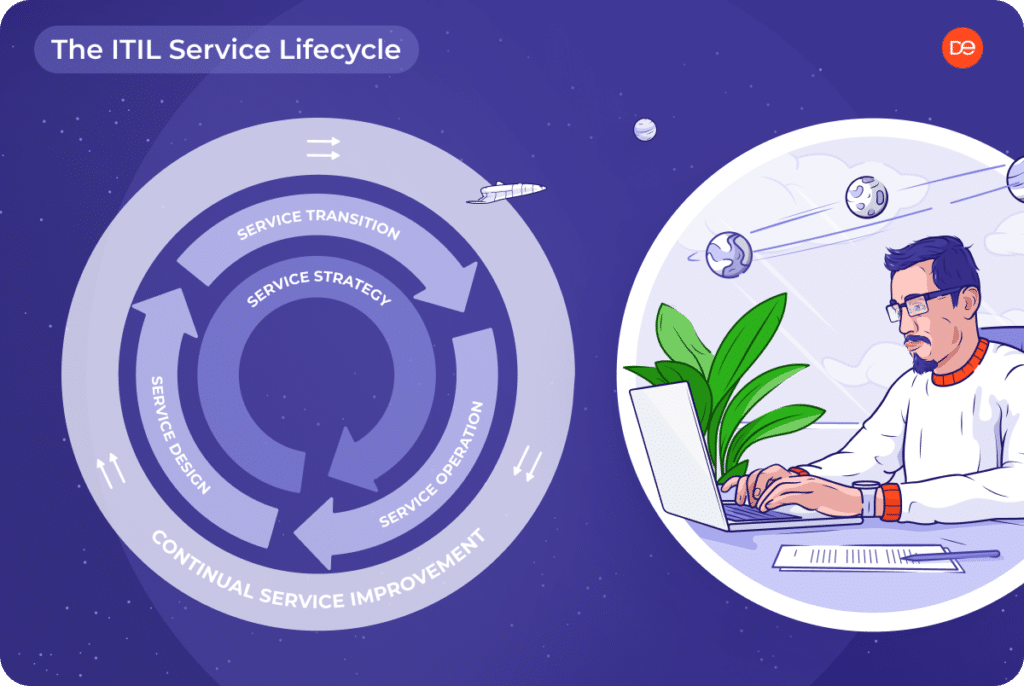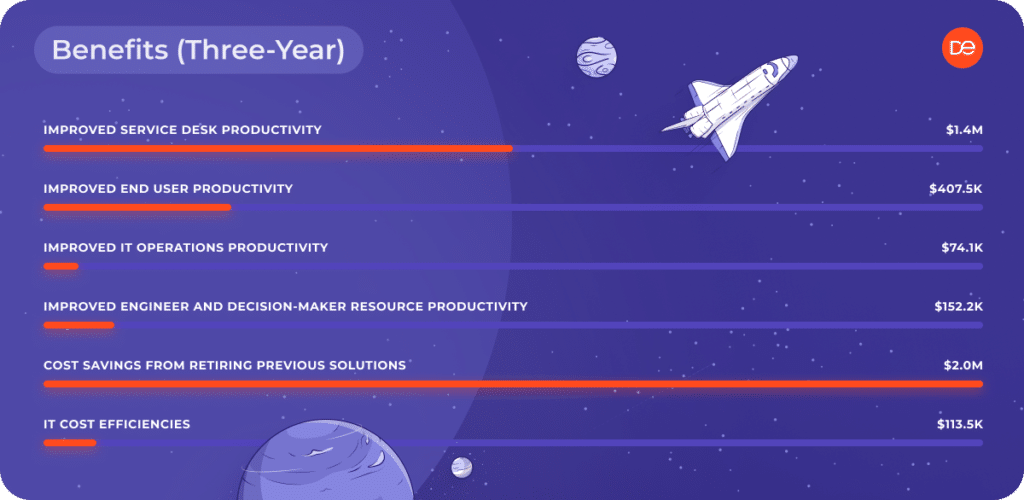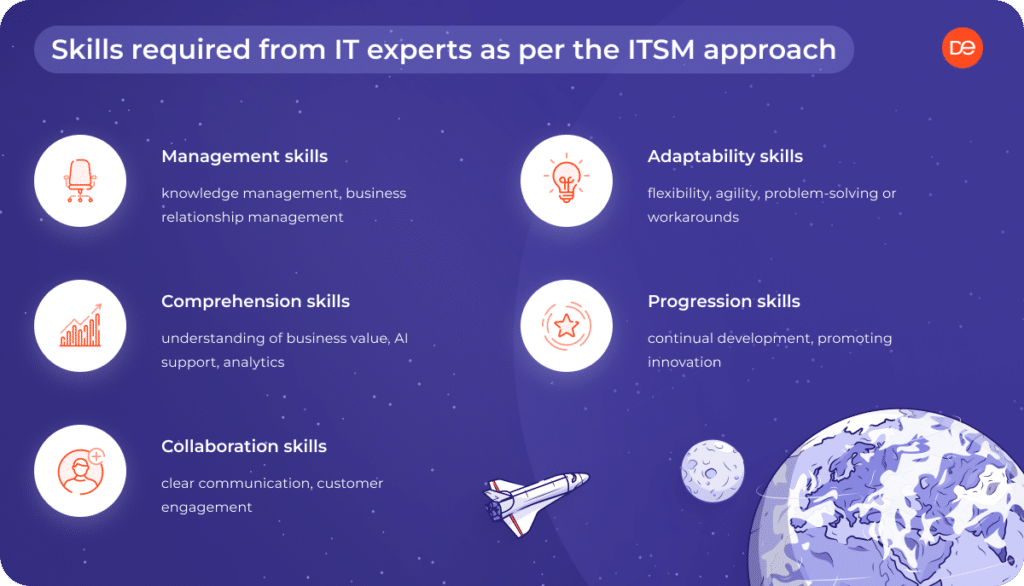5 steps to highly efficient IT team management with ITSM

This article was updated by Dominik Letner, Content and Marketing Specialist, on 31 October 2023.
Today, IT departments are tasked with complex cases of supporting employees in their pursuit of excellence. While many teams are struggling, effective IT team management often means aligning IT operations with business goals, implementing agile methodologies and automation, and aiding in digital transformation. Many tools and methods might increase effectiveness, but which one is the best? How to handle IT team management to create a highly efficient team? Explore our tips and tricks to bring your team’s effectiveness to the highest level with a modern approach called ITSM.
According to McKinsey&Company, 45% of the work we do today can be automated. This means savings can reach 2B USD. Unfortunately, IT teams still use outdated methods of operation:
71% say they focus on risk reduction, but only 29% admit that the IT team is crucial to the company’s success.
If IT teams don’t want to be left behind, they must move on to more adaptable working methods. IT Service Management (ITSM) is an approach that allows for handling IT operations in an organized and predictable way. This makes all forms of IT cooperation easier. An even more advanced approach – Enterprise Service Management (ESM) – allows for using ITSM to pursue specific business goals. Knowing that, let’s explore how ITSM can serve you in exceptional IT team management.
How to reach efficient IT team management?
An effective IT team translates its efficiency into the entire company’s efficiency as subsequent teams and departments can digitize themselves, implement new methods and tools, etc. Higher productivity levels not only mean cost savings. It’s also improved communication that results in better relationships, both within the team and on the line of the company and the client. In this way, a chain of benefits is created – building long-term partnerships also positively affects the image of the brand and the organization. Let’s see what is worth doing and what you should remember to achieve better outcomes.
Step 1: Put your business goals first
Business processes are very complex. In the maze of tasks, it’s difficult to prioritize and determine which projects will bring real value to both the client and your organization. You shouldn’t define it by feeling nor be guided by your beliefs. Instead, conduct a thorough business analysis and establish the actual needs of your teams.
When planning work, high-performance teams are twice as often entitled to make independent decisions about IT projects and eight times more likely to synchronize their ambitions with business goals. Teams working with business goals are more likely to prioritize projects in cooperation with management. They are twice as likely to evaluate their results using business and IT criteria.
Efficient communication
The secret lies in communicating effectively with the rest of the company. Effective IT team management means understanding that, just like some other departments (marketing, HR, administration), the IT department serves the entire company. Therefore, its operation cannot be detached from the needs of the business. It should be based on them.
To reach good communication levels, your IT team management as per the ITSM approach should include rules on channels, clarity, and timeliness. The IT department as well as other departments should receive regular updates on the current situation. All stakeholders (end-users as well) should be informed about any upcoming changes, their potential impacts, and expected benefits.
The IT department should provide relevant data through reports, presentations, and discussions. Visualization methods, such as charts, graphs, and dashboards, can be employed to make data more accessible and understandable to any groups of interest. Clear communication helps build trust, consensus, and support for decision-making regarding IT activities.

Cooperation rules
ITSM practices encourage mapping IT objectives and initiatives directly to your business goals. This means that every IT project, service improvement, or investment should have a clear connection to how it contributes to achieving a specific business objective. A good idea for you here is to meet with representatives of other departments and establish objectives together so that you can adjust your IT team management style accordingly.
Another good idea involves defining Key Performance Indicators (KPIs) and metrics that align with business objectives. As a result, you can measure your department’s performance and success in terms that are meaningful to your entire company. Nevertheless, the key point is to remain flexible. You should be ready to regularly review and adjust IT strategies to stay aligned with evolving business needs. Consequently, your department will always be considered an invaluable asset to the company.
Step 2: Focus on customer needs
Focus on customer needs is a must. Positive customer experience results in long-term business relations and truly valuable partnerships. It’s worth remembering that high-performing teams measure customer satisfaction (CSAT). They’re also more likely than other teams to use ITSM tools as these tools support community collaboration and remote work.
Becoming customer-centric
Strategic alignment with business often involves a customer-centric approach. It means that you should match your efforts to improve customer experiences, as this directly contributes to customer retention and satisfaction. So, contrary to the past approach, your IT department must become actively involved in learning customer needs and fulfill them successfully.
Measuring customer satisfaction
You can increase customer satisfaction in some different ways. Firstly, you ought to learn their needs and requirements. There are several ways in which information about customer needs can be collected that will help you enhance product development. You should let your users share their opinion. Therefore, you should carefully gather their feedback, e.g., via customer portals. Thanks to that you can not only improve already existing functionalities but also get inspiration for creating new useful features. The other good idea is constant monitoring of customer satisfaction, using e.g., CSAT.
Service clarity
One way of forming a good customer relationship that fosters your IT team management is transparency of services. This includes a streamlined service request process. Users should always be able to tell what kind of service they are requesting and how to get it.
For each service, the service catalog should have defined Service Level Agreements (SLAs), Operational Level Agreements (OLAs), or service commitments. They outline the expected performance standards, availability, response times, and other service-related metrics that users can expect. What is more, the service catalog should feature a user-friendly web interface. It provides an intuitive search and navigation experience, making it easy for users to find and request the services they require.
The last thing that is crucial to customers is money. A robust service catalog must provide clear and transparent information about the costs associated with each service. This includes both one-time delivery costs and ongoing operational costs. As a result, your customers will feel much safer and become more trusting of your activities.
Step 3: Become proactive, not reactive
In the past, IT departments mostly provided the required equipment or services and responded to specific queries. Nevertheless, modern IT team management requires adopting a different, more proactive approach. IT specialists are supposed to become the driving force of many results. Consider the following ideas about making this possible.
Automation
High-performing teams don’t waste time fighting adversities and repeating tasks. They deal with basic problems through automation. Many of them claim that the use of automation has increased. In addition, high-performing teams are more likely to use problem management to avoid common emergencies.
This topic also relates to the aforesaid service catalog. This portal should be closely integrated with service request fulfillment processes. With such solutions, you can ensure that requests made through the catalog are automatically routed to the appropriate teams for processing and delivery. But the power of automation does not end with solving specific problems.
The collection and aggregation of relevant data can support data-driven decision-making which, in turn, greatly benefits the company. You can use advanced ITSM tools and monitoring solutions to automate data collection. This data can include information about IT service performance, incident reports, user feedback, system usage, and more. Thanks to collecting this data, you can come up with better procedures and solutions to support your customers and users.

Security
Another proactive approach is prevention and protection against possible failures. A good example is The Phoenix Project by Kim Gene. This is the story of a team that mostly had to deal with such emergencies. After the digital transformation, the team began to introduce innovations in the company that streamlined processes and even increased sales. Thanks to digitization and automation of repetitive processes, the team simply has time for it. That’s how they save time, cost, and energy for solving truly challenging problems.
Speaking of problems, not all of them are of equal importance. They can include system outages, software failures, security breaches, or user-reported issues. ITSM practices involve prioritizing identified problems based on their potential impact on business operations. Efficient responding begins with rapid problem identification. High-priority issues that could lead to severe disruptions or security breaches are addressed first. This allows for the uninterrupted operation of your company.
The last thing connected with security is risk assessment. Efficient IT team management means considering factors like the impact on service availability, security implications, resource requirements, and potential conflicts with existing systems or services. A thorough data analysis can also uncover potential security risks or vulnerabilities. Not to mention implementing preventive measures such as access controls and permissions applied within the service catalog. These ensure that users can only access and request services that are relevant to their roles and responsibilities.
Step 4: Implement new approaches and technologies
Implementing new technologies has become an integral part of the digital transformation of enterprises that has gained momentum in the wake of the pandemic. Many companies, not only from the IT industry, then decided to switch to remote or hybrid operations. It wouldn’t be possible without appropriate tools that facilitate communication and remote cooperation of distributed teams. But that’s not all. Tools that are well matched to the needs and individual workflow of our team can noticeably increase the efficiency of work and make it more comfortable.
Monitoring progress
Efficient teams are more willing to monitor the use of technology in the organization and come up with proposals for improvement, which just translates into digital transformation. Many organizations achieve a higher return on investment in technology. Teams acting under business goals are also three times more likely to use ITSM tools that were created less than two years ago.
One of the pinnacles of efficient IT team management is the continuous monitoring of IT systems and services. It is a crucial part of proactive problem management as well as a source of innovations. The latter mostly relates to change management that pushes your company forward. After changes are deployed, they should be closely monitored to ensure that they perform as expected. Post-implementation reviews (PIRs) are a good tool to evaluate the success of the change and identify any areas for improvement.
There is one more benefit coming from successful monitoring. By analyzing gathered historical data, your IT team can identify trends and patterns that provide valuable insights. For example, recognizing a recurring incident trend may prompt proactive problem-management efforts. Advanced ITSM systems may incorporate predictive analytics to forecast future trends and potential issues. Then you can act before they escalate to avoid disruptions and additional costs.
Cost control
Since we mentioned costs, it’s time to expand the topic. ITSM helps IT departments make cost-effective decisions by ensuring that investments in technology and services directly contribute to achieving business goals, thus avoiding unnecessary expenses. What is more, the data accumulated in the monitoring stage can highlight inefficiencies or areas where costs can be reduced. You can use data to make informed choices that optimize IT operations.
Implementation of new technologies is always a strategic decision. Therefore, even if it is made on the team level, it needs commitment from company management. And that means focusing on the direct and indirect costs of tooling. The winners are open platforms, no-code or less-code solutions that allow rapid adoption within the organization, flexibility in shaping processes, and finally – user-friendliness.
Streamlined contact
In addition to tools that facilitate teamwork, it’s also worth considering the use of new technologies in your products and solutions that allow you to contact customers. Modern tools often help in serving both types of users: internal (company employees) and external (typical customer support). By providing the highest level of customer experience, you can be sure that they will be more willing to use your services in the future.
Another side of the coin is remaining in contact even if you aren’t in contact. Sounds strange? Not at all! ITSM encourages knowledge sharing and collaboration among team members. Cross-functional teams collaborate on projects and share insights, experiences, and innovative ideas. You should prepare detailed documentation on any events, including what worked well and any lessons learned. Such an approach is essential for knowledge sharing within the IT department. This knowledge base helps improve future change initiatives. What is more, you can use it with customers as well (although in a modified version) within a self-service portal.
Step 5: Invest in tools that accelerate work
In this case, when we talk about collaboration tools, we don’t mean only digital tools. Tools are not only products but also frameworks and methodologies that improve and organize work. There are many different methodologies, but it’s impossible to say if any is better or worse. The secret is to adjust the methodology to the needs of a given project, team, and company. If you choose a methodology that supports individual workflow, you can be sure that the efficiency of your team will increase. If you decide to use an inappropriate methodology that doesn’t reflect your actual needs, it may turn out that instead of making everyday tasks easier, you have introduced an additional difficulty.
IT methodology
The methodology has a big impact on the speed of work. It’s hard to believe, but high-performing teams only invest too little in ITIL technology. And yet, ITIL seems to be the most popular methodology. It suggests that ITIL is truly a must-have, not only for tech teams. This is mainly due to three factors:
- governance requirements – ITIL still translates the best enterprise governance needs into operational goals, while being cooperative with agile models;
- ITIL processes, especially with modern ITIL version – v. 4 – are lean, and it seems that finally market understands that guidance coming from ITIL is not conformity to the book, but adaptivity to the spirit;
- the ITIL scope covers the full lifecycle of business processes and supporting IT services and products, making it the most complete definition of the IT world available to date.
The question here is whether non-technical teams also need a work-management methodology. There is one answer, of course, they do. The best example is Agile, which can be successfully adapted to the needs of various types of teams, not only IT, but also marketing, HR, and sales.
Resource allocation
Adopting the right methodology can help you in more prolific decision-making. When you add appropriate solutions, your IT team management as well as company management can greatly benefit. The key is the proper arrangement of available resources. Strategic alignment ensures that IT resources, including budget, personnel, and technology, are allocated in a way that supports critical business initiatives. This involves prioritizing projects and investments based on their potential impact on business outcomes.
To make matters more interesting, ITSM helps IT departments make cost-effective decisions by ensuring that investments in technology and services directly contribute to achieving business goals, thus avoiding unnecessary expenses.

How to form a highly efficient team
The secret of highly efficient IT team management is to combine awesome customer experience with modern digital technologies. We can increase customer satisfaction by measuring CSAT indicators, linking CSAT revenues and measurements to projects, investing in proper tools that will raise positive reactions, and managing service across the entire company. From the technical point of view, the most important is to create a digital transformation plan, use automation to solve basic problems, implement Lean and DevOps solutions, and invest in Agile and DevOps.
In general, to be effective, the team must have clearly defined goals and ways to measure their effectiveness. It’s always good to try technologies such as artificial intelligence, machine learning, or predictive analytics. But the most important thing is synchronizing the team’s ambitions with the company’s goals and celebrating the success together.
Bring your IT team management to another level!
We hope that our tips will lead your team to the galaxy of effectiveness. If you want to learn more about IT team management with ITSM, make sure to take a look at our FREE and comprehensive e-book on improving your IT department with ITSM.



